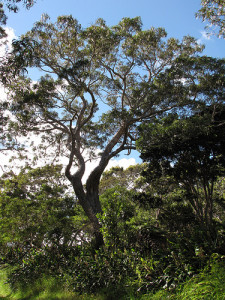By Caroline Brooks, Communications Intern
American Forests’ Hawaiʻi Wild Forestscape adventure in October will take our group to the Kona district, where we will enjoy the beaches and coffee plantations that characterize the area. In addition, our quest to understand the island’s endangered flora and fauna will continue as we discover the history and conservation efforts surrounding the koa tree.

Photo: Forest & Kim Starr/Flickr
Centuries ago, the native koa tree dominated the forests here. The arrival of colonists and settlers to Hawaiʻi resulted in degradation of the land, with foreign plants and animals, disease and deforestation contributing to the decline of the koa population.
Additionally, high demand for the tree’s wood has strained the number of remaining koas. The species is cherished for its curly grain and array of colors, rendering it one of the island’s most valuable timber sources.
However, the koa possesses worth beyond its timber. Mature trees function as habitat for several endangered birds: the akiapolaau, akepa and Hawaiian creeper. Koa also produce a large percentage of leaf biomass that freshwater fish eat.
That’s why our group will not only learn about conservation work happening in the area, but we will participate in the effort as well. We will make our way to a Hawaiian Legacy Hardwoods project in the mountains, dedicated to reforesting land that has been cleared for grazing. At the site, every member of our group will have the chance to plant a koa tree. The planters will receive the GPS coordinates of their seedlings so they can track their tree’s progress for years to come.
Planting a koa tree is one step on the path to restoring and protecting Hawaiʻi’s indigenous marvels. It guarantees that native Hawaiian wildlife will always have food and shelter. It satisfies the demand for valuable timber. Above all, planting a koa tree ensures that the king of Hawaiian forests will always have its crown.
Read about some of the other plants and animals that we will encounter on Hawaiʻi Wild:
- Hawaiʻi Wild Part One: A young state with an ancient history — American Forests’ upcoming Forestscape adventure will introduce guests to the diverse species that once lived in abundance under the Island’s spacious skies as well as to the valiant efforts to protect them from invasive, destructive forces.
- Hawaiʻi Wild Part Two: Something to crow about in Hawaiʻi —The Hawaiian crow is one of the state’s most critically endangered species; however, a San Diego Zoo program solemnly strives to reform this status.
- Hawaiʻi Wild Part Four: National park loyal to native wonders — Hawaiʻi Volcanoes National Park is intent in its duty to restore endangered plant and animal species so they can freely roam the land that they call home.